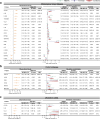Associations of 2923 plasma proteins with incident inflammatory bowel disease in a prospective cohort study and genetic analysis
- PMID: 40118817
- PMCID: PMC11928603
- DOI: 10.1038/s41467-025-57879-3
Associations of 2923 plasma proteins with incident inflammatory bowel disease in a prospective cohort study and genetic analysis
Abstract
The prospective relationship between proteomics and inflammatory bowel disease (IBD) remains largely underexplored, presenting potential of therapeutic interventions. Using data from 48,800 IBD-free participants in the UK Biobank Pharma Proteomics Project (UKB-PPP), we assessed associations between 2923 plasma proteins and incident IBD risk using Cox analysis. Mendelian randomization (MR) meta-analysis, integrating cis-protein quantitative trait loci data from the UKB-PPP with IBD genome-wide association study data from the International Inflammatory Bowel Disease Genetics Consortium and FinnGen studies, identified causal proteins. Colocalization analysis strengthened evidence of shared common causal variants. Cohort study revealed associations of 673, 295, and 125 proteins with the risk of IBD, Crohn's disease (CD), and ulcerative colitis (UC), respectively. MR and colocalization analyses prioritized IL12B, CD6, MXRA8, CXCL9, IFNG, CCN3, RSPO3, and IL18 as having causal and high colocalization evidence with IBD or its subtypes. Our findings advance understanding of IBD's molecular etiology and highlight potential therapeutic targets.
© 2025. The Author(s).
Conflict of interest statement
Competing interests: The authors declare no competing interests.
Figures




References
-
- Ng, S. C. et al. Worldwide incidence and prevalence of inflammatory bowel disease in the 21st century: a systematic review of population-based studies. Lancet (Lond., Engl.)390, 2769–2778 (2017). - PubMed
-
- Kaplan, G. G. The global burden of IBD: from 2015 to 2025. Nat. Rev. Gastroenterol. Hepatol.12, 720–727 (2015). - PubMed
-
- Danese, S., Sans, M. & Fiocchi, C. Inflammatory bowel disease: the role of environmental factors. Autoimmun. Rev.3, 394–400 (2004). - PubMed
-
- Danese, S., Solitano, V., Jairath, V. & Peyrin-Biroulet, L. The future of drug development for inflammatory bowel disease: the need to ACT (advanced combination treatment). Gut71, 2380–2387 (2022). - PubMed
MeSH terms
Substances
Grants and funding
- 82103912/National Natural Science Foundation of China (National Science Foundation of China)
- 82204129/National Natural Science Foundation of China (National Science Foundation of China)
- 82173591/National Natural Science Foundation of China (National Science Foundation of China)
- tsqn202312328/Taishan Scholar Project of Shandong Province
- tstp20230654/Taishan Scholar Project of Shandong Province
LinkOut - more resources
Full Text Sources
Medical
Research Materials
Miscellaneous

